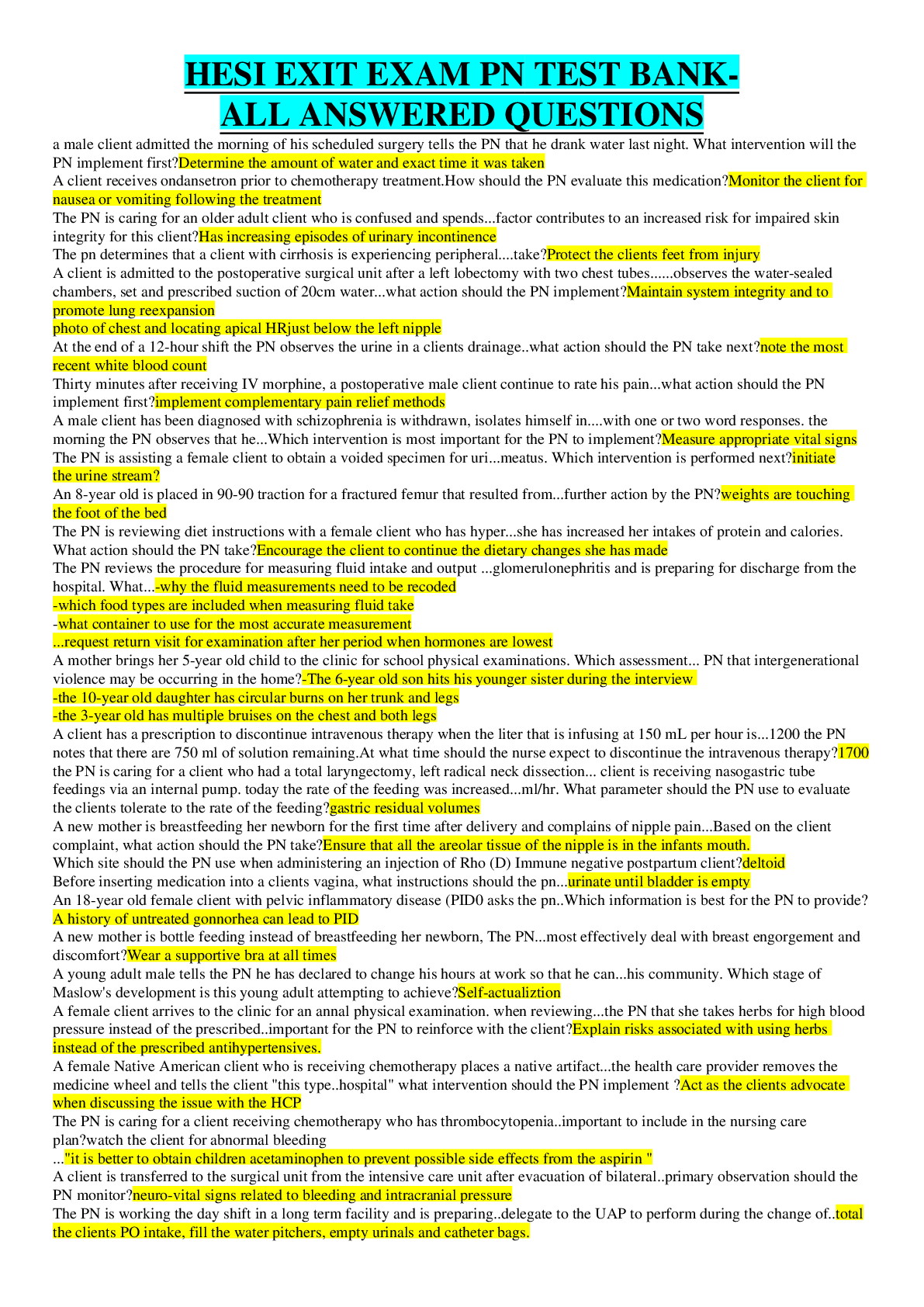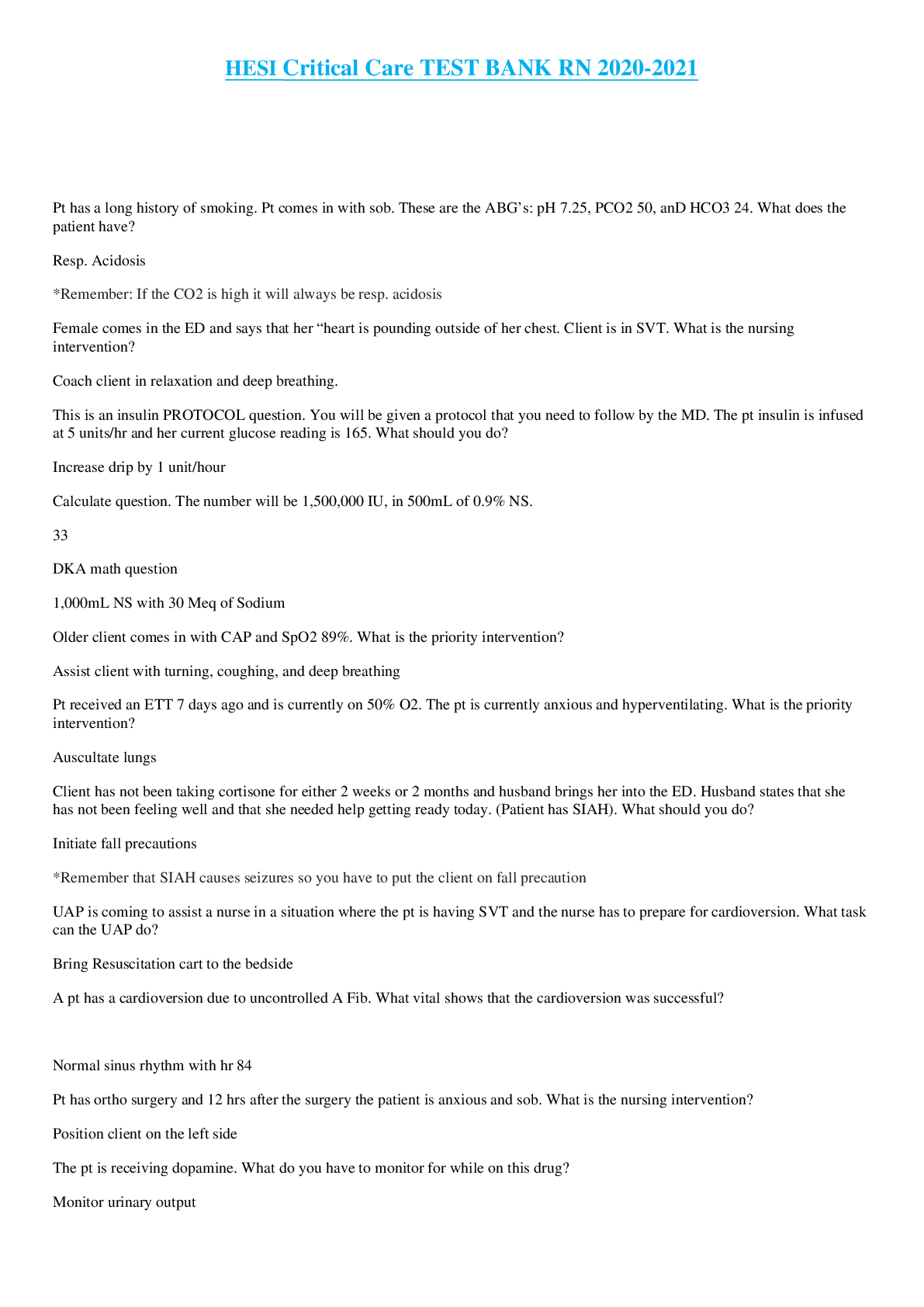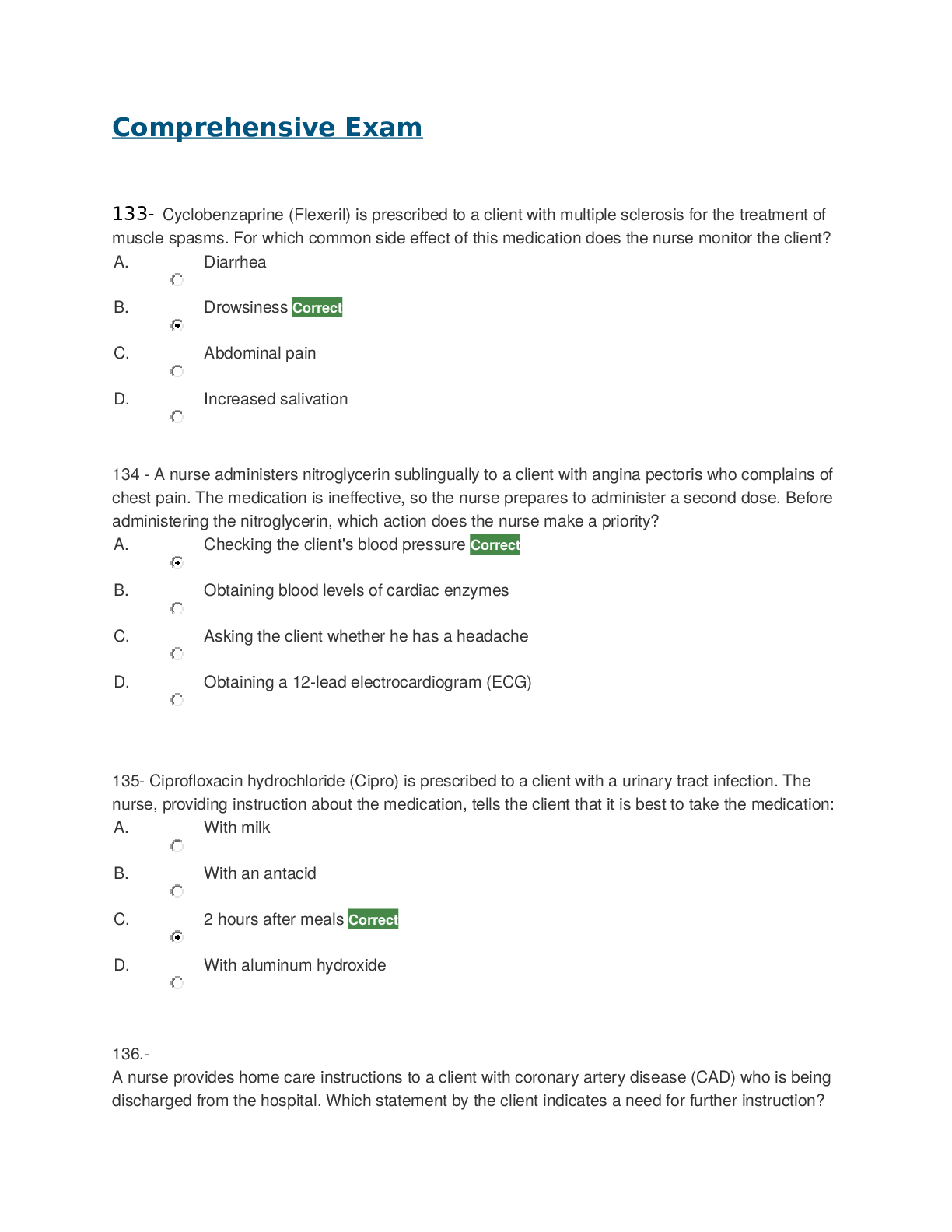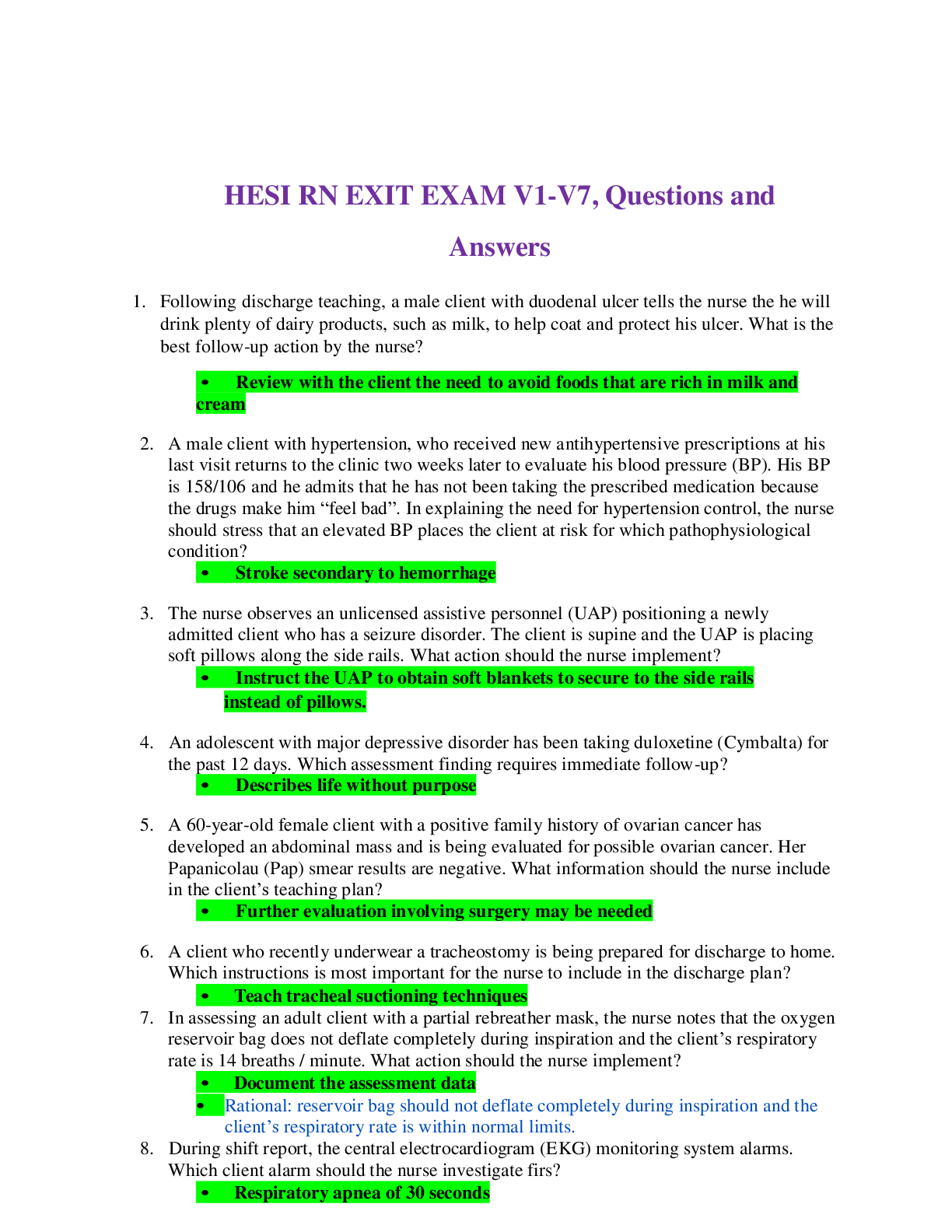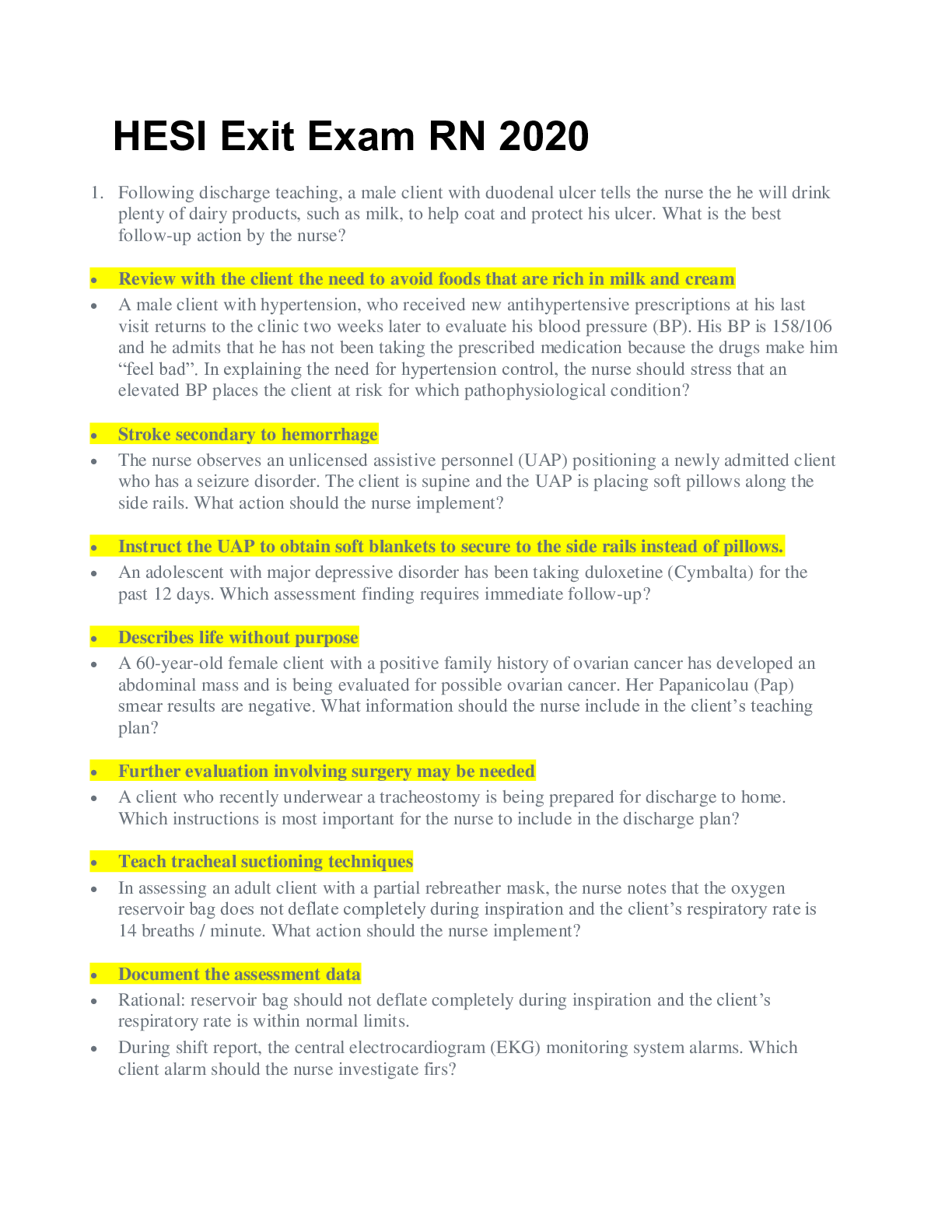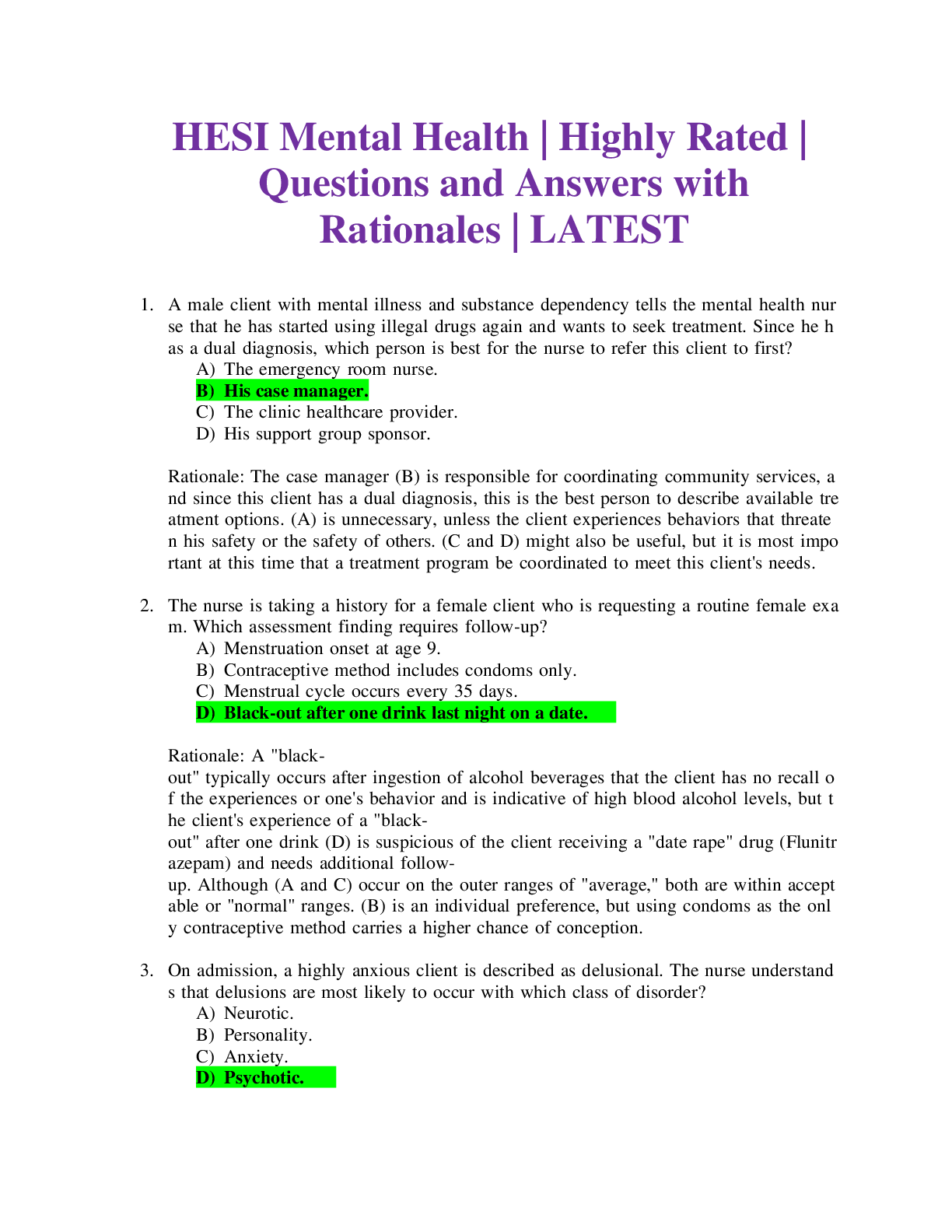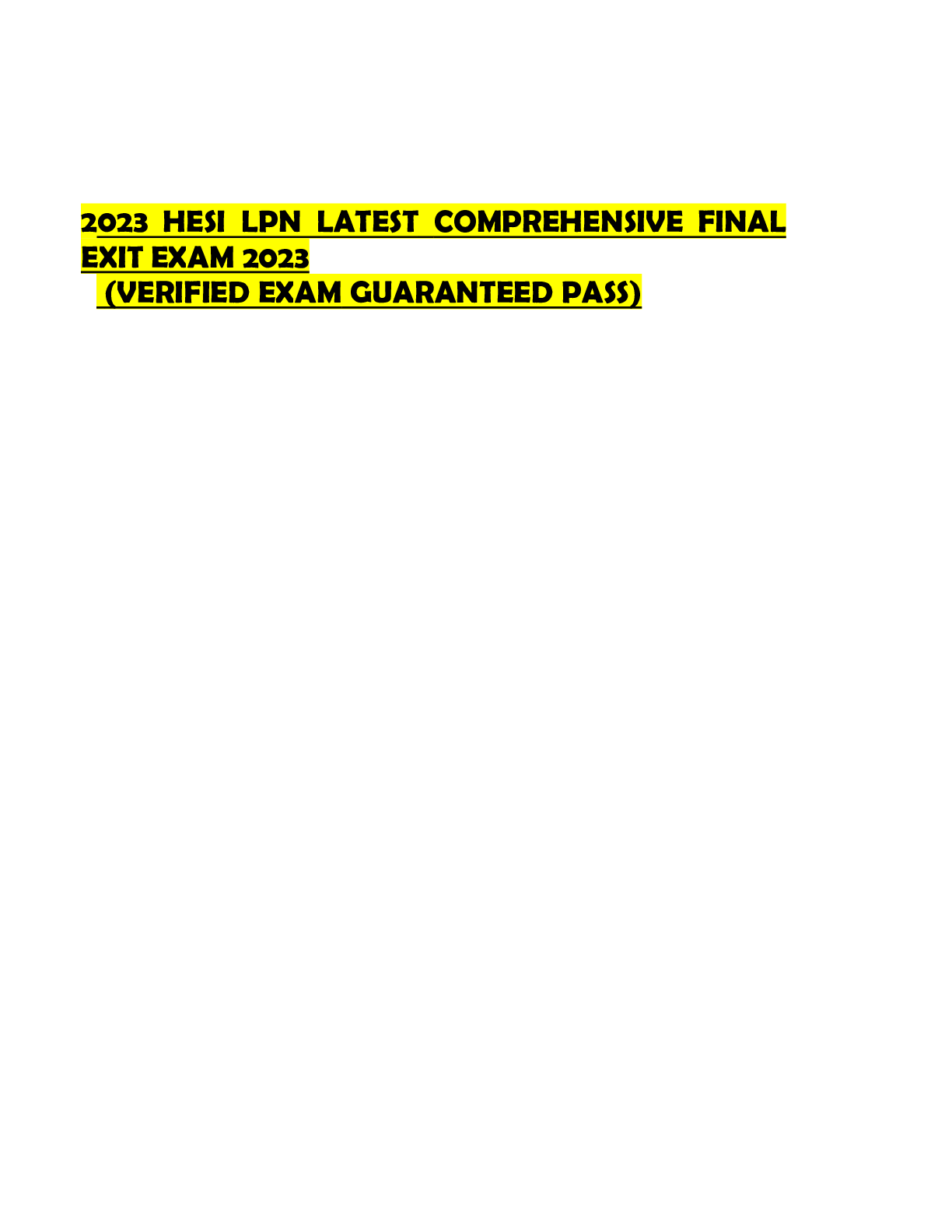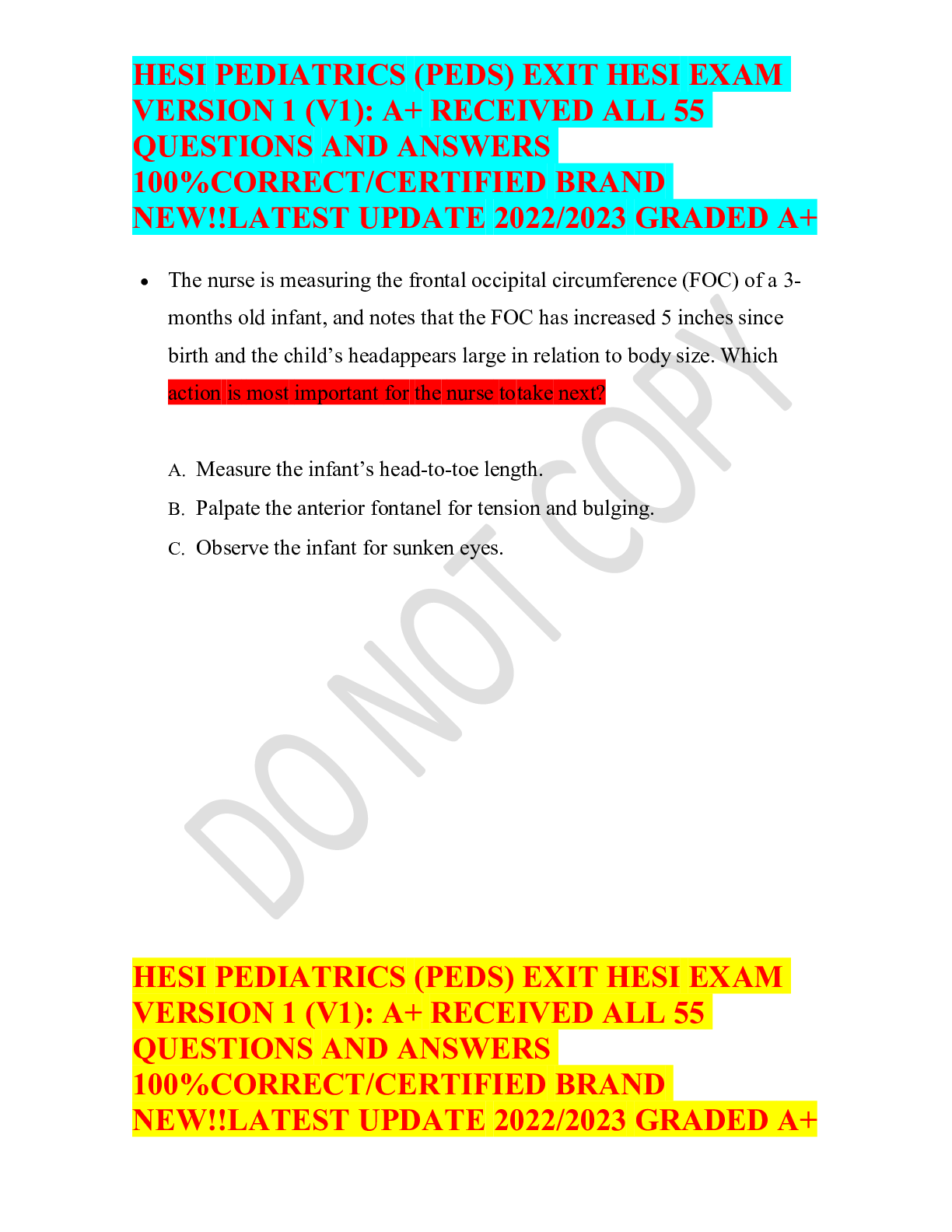*NURSING > HESI > HESI Med-Surg NURSING PRACTICE FINAL EXAM. Final Test Questions Submission With Rationale and refere (All)
HESI Med-Surg NURSING PRACTICE FINAL EXAM. Final Test Questions Submission With Rationale and references. 100%.
Document Content and Description Below
HESI Med-Surg NURSING PRACTICE FINAL EXAM. When preparing discharge teaching for a 27 year old female diagnosed with multiple sclerosis, the nurse knows to include: a) decrease fiber intake b) ad... dressing different methods of birth control c) recommend joining a gym or a competitive sport d) suggest that coffee or energy drinks should only be taken early in the day to decrease fatigue and to avoid interfering with sleep Rationale: pregnancy can lead to undue stress and is also associated with being a precipitating factor. Iggy chapter 45 pg.983 ppt and lecture 1. What does an inverted T wave signify? (Select all that apply) a) Hypokalemia b) Hyperkalemia c) Pulmonary Embolism d) Left Ventricle Hypertrophy e) Right Ventricle Distension Answers: 1, 3, 4; Iggy Chapter 36, pg. 717 Rationale: T wave inversion can be an indication of hypokalemia, pulmonary embolism or left ventricle hypertrophy. (This is from my notes, but all answers are in Chapter 36) 2. The nurse is assessing a patient with left-sided heart failure. Which assessment findings does the nurse expect to see in this patient? (Select all that apply) a) Displacement of the apical impulse to the left b) S³ heart sound c) Paroxysmal nocturnal dyspnea d) Jugular venous distention e) Oliguria during the day f) Wheezes or crackles Clinical Decision-Making Study Guide; Medical Surgical Nursing-Patient Centered Collaborative Care, 7th Edition Revised Reprint; Ignatavicius, Workman; Ch 37,Pg346 item #15 3. A nurse is caring for a 50-year old male with a diagnosis of Amyotrophic lateral sclerosis (ALS). The patient understands there is no cure for ALS and is taking Riluzole (Rilutek). The nurse teach the patient to monitor for signs and symptoms of: a) Nephrotoxicity b) Heart failure c) Liver toxicity d) Dehydration Rationale: Riluzole causes Liver toxicity and patients should be taught to watch out for signs and symptoms like vomiting and jaundice. The other choices are not caused by Riluzole. (IGGY Chapter 45, page 984) 4. You are viewing the cardiac monitor in a client’s room and note that the client has just gone into ventricular tachycardia. The client is awake and alert and has good skin color. The nurse would prepare to do which of the following? a) Prepare for immediate synchronized cardioversion b) Prepare for pacemaker insertion c) Administer amiodarone (Cordarone) intravenously d) Administer epinephrine (Adrenaline) intravenously Rationale: patient is hemodynamically stable, the patient is alert and awake with good skin color, which indicates adequate perfusion, patient is in stable V-tach w/a pulse, which is treated with oxygen and IV antidysrhythmics. For the stable patient with sustained VT, administer oxygen and confirm the rhythm via a 12-lead ECG. Amiodarone, lidocaine, or magnesium sulfate may be given. Iggy 7th edition chapter 36 care of patients with dysrhythmias page 729 5. A patient on mechanical ventilation has been transferred from the ICU to a Step-down care unit. The Physician is planning to wean the patient from dependent ventilator support. The prudent nurse anticipates the physician will change the ventilator to what type of mode? a) SIMV b) AC c) PIP d) PEEP Rationale: Iggy 7th Edition Chapter 34 pg.678 Unlike Assist Control (AC) ventilation, SIMV (Synchronized Intermittent Mandatory Ventilation) allows spontaneous breathing at the patients own rate and tidal volume between the ventilator breaths. When used for weaning, the number of mechanical breaths is gradually decreased (i.e. from 12 to 2 breaths) and the patient gradually resumes spontaneous breathing. PIP (Peak Inspiratory Pressure) and PEEP (Positive End Expiratory Pressure) are not ventilator modes, they are settings used within the modes of mechanical ventilation support. 6. The physician has prescribed barbiturate coma therapy for a pt with increased ICP. For which complication will the nurse monitor for? a) Decreased Loc b) Reduced gastric motility c) Decreased respiratory rate d) Decreased Glascow coma scale score . Rationale: pg 1028 Complications of barbiturate coma include decreased GI motility, cardiac dysrhythmias from hypokalemia, hypotension, and fluctuations in body temperature. 7. The nurse is caring for an intubated pt with increased ICP. If the patient needs to be suctioned, which nursing action does the nurse take to avoid further aggravating the increased ICP? a) Manually hyperventilate with 100% oxygen before passing the catheter b) Maintain strict sterile technique when performing endotracheal suctioning c) Perform oral suctioning frequently, but do not perform endotracheal suctioning. d) Obtain an order for an ABG before suctioning equipment. Rationale : pg 1027 If the patient is intubated , manually hyperventilate them with 100%oxygen before each pass of the catheter 8. A 65 year old, male arrived to the ER with clinical manifestations of crackles, dyspnea, and shortness of breath. The health care provide suspects congestive heart failure. After interventions to decrease fluid in heart the doctor inserts a pulmonary artery wedge pressure (PAWP) to assess the patient fluid volume. Which readings indicate a normal mean pressure? (SATA) a) 8 mm Hg b) 3 mm Hg c) 12 mm Hg d) 15 mm Hg e) 4 mm Hg Rational: Iggy, Pg. 709, Chapter 35: Assessment of the cardiovascular system PAWP closely reflects left atrial pressure and LVEDP in patients with normal left ventricular function, normal heart rates, and no mitral valve disease. The PAWP is a mean pressure and normally ranges between 4 and 12 mm Hg 9. A patient in the ICU is currently receiving SIMV mechanical ventilation. What nursing responsibilities are appropriate for this patient? Select all that apply. a) Assess the breathing pattern in relation to the ventilatory cycle. b) Change ventilator settings if patient is not tolerating/fighting the current settings. c) Provide endotracheal suctioning as needed when adventitious breath sounds are noted (i.e. wheezing, rhonchi) d) If the patient develops respiratory distress during mechanical ventilation, immediately remove the ventilator and provide ventilation with a bag-valve mask device. 10. A male client comes in to clinic with complains headaches, vision changes, and join pain. This morning he stated that his wedding ring was feeling tighter on his finger. He is diagnosed with a tumor in the anterior pituitary cell. Which hormone is being affected by the tumor? a) Thyrotropin b) Somatotropin c) Gonadotropins d) Adrenocorticotropic Iggy 7th edition Chapter 65 pgs1372-1376 The manifestations of hyperpituitarism vary, depending on which hormone is produced in excess. Obtain data about the patient’s age, gender, and family history. Ask about any change in hat, glove, ring, or shoe size. Fatigue and lethargy are common. The patient with high GH levels may have backache and arthralgias (joint pain) from bone changes. Ask specifically about headaches and changes in vision. Initial manifestations of GH excess are increases in lip and nose sizes, a prominent brow ridge, and increases in head, hand, and foot sizes. Iggy 7th ch.28 pg. 515 11. A client has burns to the chest. The area appears white and leather-like. No blisters or bleeding is present, and the client describes just a "small amount of pain." How does the nurse categorize this injury. a) Partial thickness deep b) Partial thickness superficial c) Full thickness d) Superficial ANS: C Iggy 7th ch.28 pg. 517 12. The physician has ordered IV cimetidine (Tagamet) for a client with a new burn injury. What is the nurse's best response when the client asks the nurse why he is receiving this drug? a) "Tagamet will stimulate intestinal movement so you can eat more." b) "Tagamet can help prevent hypovolemic shock, which can be fatal." c) "This will help prevent stomach ulcers, which are common after burns." d) "This drug will help prevent kidney damage caused by dehydration." 13. Patient experiencing type 4 heart failure symptom manifestations include: a) Slow deep breathing b) Chest pain or pressure c) BP 102/80 d) Crackles in lungs e) Urine output 80 mL in 2 hours. Rationale: Pg.842. Patient experiencing signs and symptoms of cardiogenic shock include: Tachycardia, hypotension, BP less than 90 mm Hg or 30 mm Hg less than the patient’s baseline, urine output less than 30mL/hr, cold, clammy skin with poor peripheral pulses, agitation, restlessness, or confusion, pulmonary congestion (crackles), tachypnea (rapid breathing), continuing chest discomfort (pain or pressure). 14. An older adult presents to the emergency department, which of following puts him at risk for cardiogenic shock? a) Immobility b) Diabetes mellitus c) Pulmonary hypertension d) Abdominal aortic aneurysm Risk factors associated with cardiogenic shock include diabetes mellitus and presence of cardiomyopathies. Immobility and aortic aneurysm puts a patient at risk for hypovolemic shock. Pulmonary hypertension is a risk factor for obstructive shock. Ignatcvicius Chart 39-5 Nursing Focus on the Older Adult Pg.823 15. The nurse is planning strategies to prevent the onset of ventilator-associated pneumonia for a client who is being mechanically ventilated. Which strategy should be included in this client's plan of care? a) Decontaminate hands before applying gloves for care. b) Perform hand hygiene with soap and water. c) Dispose of all reusable devices used for respiratory therapy. d) Perform oral hygiene twice a day using a soft toothbrush. 16. A patient arrives to the Emergency Room in respiratory distress; a family member tells the nurse that he suffers from Myasthenia Gravis. The Physician orders a “Tensilon Stress Test” stat. After 2 minutes, the patient’s symptoms have a slight improvement. What does this mean? a) The patient is experiencing an Asthma Attack b) The patient is experiencing a Bronchitis Crisis c) The patient is experiencing a Myasthenic Crisis d) The patient is experiencing a Cholinergic Crisis 17. A patient is about to be discharged and is diagnosed with Myasthenia Gravis. During his teaching about pyridostigmine (Mestinon), the nurse understands that the client needs additional teaching when he states that? (Select all that apply) a) My medication will always be the same dose and same time. b) I will take my medication after eating a full meal. c) Always take my medication first and then eat 45 min to 1 hr. after d) This drug is called an anticholinesterase and will help me with my muscular problems. e) I will continue taking my antibiotic (neomycin) until I complete the treatment. 18. A client with diabetes mellitus has had declining renal function over the past several years. Which diet regimen should the nurse recommend to the client on days between dialysis? a) A low-protein diet with an unlimited amount of water b) No protein in the diet and use of salt sparingly c) A low-protein diet with a prescribed about of water d) A high-protein diet with a prescribed amount of water 19. A 55 yr. old obese patient comes into the ED with a diagnosis of acalculous cholecystitis. The nurse understand that risk factors for acalculous cholescystitis are: (Select all that apply) a) Hypervolemia b) Multi-system organ failure c) Sepsis d) Major surgery e) Severe trauma or burns 20. A nurse is assessing a patient diagnosed with Guillan-Barre Syndrome what clinical manifestations would the nurse except to observe? a) Loss of bladder and bowel control b) Ptosis and tremors c) Weakness of the hands and tongue atrophy d) Ascending muscle weakness and paresthesias 21. A patient diagnosed with Hepatitis C is being discharged today. What would the nurse include in the discharge instructions for this patient? Select all that apply a) Avoid over-the-counter drugs such as acetaminophen unless prescribed by your doctor b) Eat low carbohydrate and high caloric meals frequently throughout the day c) Get sufficient rest during the day, and get adequate sleep at night d) Avoid sexual intercourse until antibody testing results are negative. e) Reduce alcohol consumption 22. The community nurse is conducting a teaching on how to prevent Hepatits A in adults. The nurse should include which instructions in her teachings: a) Receive immunoglobulin within 14 days If exposed to the virus b) Avoid unsanitary tattoo equipment c) Do not share razors, toothbrushes or pierced earrings d) Avoiding sharing needles during illicit IV drug use . 23. A 58 y/o Female presents to the ED with complaints of “sharp, jabbing pain to one side of the face” after a dental procedure. She reports her mother suffered from chronic facial pain as well. Which of the following will the nurse suspect? a) Bell’s Palsy b) Myasthenia Gravis c) tic douloureux d) Restless leg syndrome 24. The health care provider is assessing a patient with diagnosis of Parkinson's disease. Which of the following findings would the health care provider anticipate? ( select all that apply) a) Kyphosis b) Depression c) Bradykinesia d) Receptive aphasia e) Exophthalmos 25. A patient in the ER develops respiratory alkalosis, which ABG results would the nurse interpret in this condition? a) pH 7.52, PaCo2 45, bicarbonate 36, PaO2 95 b) pH 7.45, PaCo2 50, bicarbonate 42, PaO2 88 c) pH 7.48, PaCo2 24, bicarbonate 22, PaO2 95 d) pH 7.28, PaCo2 52, bicarbonate 24, PaO2 90 27. A 52 year old male has just had a tracheostomy tube inserted 72 hours ago. What priority equipment should the nurse have readily available at the bedside? (select all that apply) A. an obtrurator, equal in size B. a bag-valve mask C. an obtrurator, one size smaller D. oral suctioning equipment E. Kelly clamp 29. A patient and his wife are learning about tracheostomy care. Which statement made by the wife would indicate to the nurse the need for further teaching? A. "small amounts of bleeding from the incision is expected for the first few days" B. "use half-strength hydrogen peroxide to clean the inner cannula and sterile saline to rinse" C. "secure new ties in place before removing soiled ones to prevent decannulation" D. "two or three fingers should be able to be placed between the tie and the neck" ans. D 30. The health care provider is assessing a patient with diagnosis of Parkinson's disease. Which of the following findings would the health care provider anticipate? ( select all that apply) a) Kyphosis b) Depression c) Bradykinesia d) Receptive aphasia e) Exophthalmos 31. A PATIENTS CSF SHOWED AN INCREASE PROTEIN LEVEL. PATIENT REPORTS A FEELING OF TINGLING OR “CRAWLING-SKIN” SENSATION ON LOWER EXTREMITIES AND SEEMS TO BE ASCENDING. THE PHYSICIAN PERFORMS A LUMBAR PUNCTURE TO DIAGNOSE.. a) GUILLAIN-BARRE SYNDROM b) PARKINSON DISEASE c) HUNTINGTON DISEASE d) MYASTHENIA GRAVIS 32. During a neurological assessment the patient fails to respond to the nurse’s verbal stimuli. Following the sequence of the Rapid Neurological Assessment, which would the nurse perform next? (Select all that apply). a) Gently shaking him/her b) Supraorbital pressure c) Trapezius muscle squeeze d) Mandibular pressure e) Sternal rub Answer: A, B, C, D, E Rationale: The Rapid Neurological Assessment (Neuro Check) in a patient requires for the nurse to assess the patient’s neurological status following a sequence from least harmful to most painful stimulation (verbal to physical pain stimulation). Pg. 918, Ignatcvicius, 7th edition 33. When determining the cause of a systemic infection in patients with a neurological problem, the nurse will expect for the physician to order what laboratory test. a) Urinalysis b) Swab test c) Blood culture d) Lumbar Puncture 34. A 42 yr. old female is in the ED with a diagnosis of pheochromocytoma. The nurse understands that this disease process has which of the following clinical manifestations? (Select ALL that apply.) a) Severe headaches b) Weight gain c) Sense of impending doom d) Vomiting e) Cold intolerance . Chapter 35 Hemodynamics 35. An ICU nurse is caring for a patient that is being hemodynamically monitored. What is the nurse monitoring to verify the patient is in a stable condition? Select all that apply. a) Pump effectiveness b) Blood pressure c) Tissue perfusion d) Vascular capacity e) Blood volume 36. A critical care nurse is preparing to assist a doctor insert a hemodynamic monitor to a critically ill patient. The nurse needs to gather the equipment for the pressure monitoring system. What items does the nurse need for this procedure? Select all that apply. a) Pressure catheter b) Signed consent form c) Catheter with an infusion system d) A transducer e) A monitor 37. The nurse is caring for a patient that is being hemodynamically monitored. What information does the nurse record every 1 – 4 hours to help guide the medical therapy? Select all that apply. a) RA pressure b) PA pressure c) Left ventricular end–diastolic pressure d) LA pressure e) PAW pressure 38. A nurse is preparing to perform an assessment on a client being admitted to the hospital with Cushing's disease. When performing the assessment, the nurse checks for which significant manifestation of the disorder? a) fluid retention b) stretch marks c) goiter d) hirsutism 39. Acute respiratory distress syndrome (ARDS) is acute respiratory failure with which of the following features: (Select all that apply) a) Hypoxemia that persists even with 100% oxygen b) Decreased pulmonary compliance c) Dyspnea d) Noncardiac associated bilateral pulmonary edema e) Dense pulmonary infiltrates on x-ray Medical Surgical Nursing, Ignatavicius pg. 671 40. When caring for a patient with SIADH, the nurse anticipates which electrolyte abnormality? a) Hypokalemia b) Hyperkalemia c) Hypocalcemia d) Hyponatremia 41. The healthcare provider is assessing a patient with Parkinson’s disease. Which of the following assessments will the healthcare provider anticipate? a) Diplopia b) Lhermittes sign c) Ptosis d) Lead pipe rigidity 42. A patient’s lab results read hemoglobin 5g/dl and present multiple body system manifestations. What possible nursing assessments could the nurse anticipate to find in this patient? Select all that apply. a) Splenomegaly b) Dyspnea at rest c) Exertional dyspnea d) Heart failure e) Systolic murmurs 43. The student nurse is discussing correct administration of iron with the registered nurse taking care of a patient with iron deficiency anemia. Which of the following is not a correct statement by the student nurse. a) Oral iron should be taken about 1 hour before meals. b) Ascorbic acid enhances iron absorption. c) Parenteral administration is contraindicated due to its irritating effects. d) If diarrhea develops, the dose may need to be adjusted. 44. The patient with pernicious anemia understands the dietary regimen when he includes which of the following foods in his daily nutritional intake? a) citrus fruits b) processed meats c) organ meats d) green, leafy vegetables e) coffee 45. Patient was admitted to the hospital with a medical diagnosis of respiratory alkalosis, a first semester student asked a newly graduated nurse ‘what are the causes of respiratory alkalosis?” what is the best response from the new GN? Select all that apply. a) Mechanical ventilation b) Pulmonary embolism c) Anxiety d) Fear e) COPD 46. A student nurse who is about to take the final exam is breathing rapidly, how would you anticipate the results of the pH? a) pH 7.25 b) pH 7.38 c) pH 7.50 d) pH 7.41 47. The nurse is to discharge a patient who was admitted with metabolic alkalosis. What is a priority teaching to this patient? a) Avoid intake of sodium bicarbonate b) Do not take too many salicylate medication c) When anxious, try breathing in a bag d) Wear sunscreen or protective clothing when outside 48. A client is scheduled to have dialysis in 1 hour and is has medications due at this time for the following medications: vitamin D, Calcium, and penicillin for an infection. Which action would be best for the nurse to take at this time. a) A: give medications with sips of water b) B: give calcium and vitamin D, but hold penicillin c) C: give penicillin and hold vitamin D and calcium d) D: hold all medications until after dialysis 49. A patient is going to dialysis for the first time and asks about the complications of dialysis. Which of the following are complications associated with dialysis? (Select All That Apply) a) dialysis disequilibrium syndrome b) infection c) developing Hepatitis or HIV d) no complications associated with dialysis e) more freedom to do what you want 50. In assessing a client recently diagnosed with acute glomerulonephritis, the nurse asks which question to determine potential contributing factors? a) “Are you sexually active?” b) “Do you have pain/ burning while urinating?” c) “Does this problem run in your family?” d) “Have you had cold or sore throat within the last 2 weeks?” 51. A patient is being discharged after stabilizing the complications associated with renovascular disease. Which nursing statement made by the patient would indicate an understanding on patient teaching? a) A: “I need to take my medication to manage my blood pressure” b) B: “After I manage my blood pressure I can stop taking my medications” c) C: “I’m so happy I can still eat fast food whenever I want” d) D:” I need to monitor my creatinine levels “ Iggy, ch: 70 page, 1531 CH. 28 Pg. 521 Age-Related Changes Increasing Complications from Burn Injury 52. Which of the following factors are age related changes that increase complications for an older burn patient? (Select all that apply) a) Thinner skin b) Sensory impairment c) Cardiac impairment d) Reduced inflammatory and immune responses e) Changes in the gastrointestinal system a) Thinner skin increases the depth of injury even when the exposure to the cause of injury is shorter duration. b) Sensory impairment increases the risk for impairment. c) Limits the aggressiveness of fluid resuscitation d) Increase the risk for infection and sepsis e) Changes in the patent’s GI system does not increase complications. 53. A nurse cares for a pateint with a low functioning anterior pituitary gland. Which hormones should the nurse expect to be affected by this condition? (Select all that apply.) a) Thyroid-stimulating hormone b) Vasopressin c) Follicle-stimulating hormone d) Calcitonin 54. After following surgery, the patients central venous pressure (CVP) monitor indicates there is low pressure. Which of the following action would the nurse initiate next? a) Elevate head of bead b) increase the IV flow rate c) give furosemide as prescribed d) document findings and continue monitoring 55. A nurse is obtaining an admission assessment on a 25 year old female who presents with a murmur, tachycardia, and pericardial friction rub. An ECG is ordered and it shows a prolonged PR interval. What priority data does the nurse inquire about? a) History of an upper respiratory tract infection with group A beta-hemolytic streptococci 3 weeks ago. b) Family history of coronary artery disease. c) Recent travel to third world countries. 56. shock? (Select all that apply) a) Increase in mean arterial pressure b) Severe tissue hypoxia c) Multiple organ dysfunction syndrome d) Urine output increases from 10mL/hr to 30mL/hr e) Homeostasis of fluid 57. A 40 year old female client came into the clinic complaining of increased sweating even when environmental temperatures are comfortable for others. The nurse suspects the client has hyperthyroidism. Which other clinical manifestations indicate hyperthyroidism? (Select all that apply) a) Weight gain b) Palpitations c) Weight loss d) Confusion e) Wide-eye or started appearance Wide-eye or started appearance (exophthalmos): The wide-eyed or “startled” look is due to edema in the extraocular muscles and increased fatty tissue behind the eye, which pushes the eyeball forward. 58. The patient is scheduled for a splenectomy. The nurse should provider further teaching if the patient makes which statement? a) "I will avoid large crowds." b) "I must wash my hands anytime I change my dressing." c) "It okay for my kids to visit me even if they are sick." 59. A nurse is providing a care plan for a patient with hypoparathyroidism due to radiation therapy as a result of laryngeal cancer which nursing intervention are appropriate for his patient? a) Stress that therapy for hypoparathyroidism is not lifelong b) Teach patient to take vitamin D 50,000-40000Units for life to maintain calcium levels at low-normal range (9.0-10.5) c) To discontinue drug therapy once it has reached normal levels (9.0-10.5 mg/dl) d) Avoid crowds or people who are ill. 60. 67-year-old Male patient came into the Emergency Department with abdominal pain that radiates to the back, with a pulsation noticeable on the abdomen. Patient currently has hypertension, atherosclerosis, hyperlipidemia, and smokes one pack of cigarettes per day. What are the nursing interventions to prevent complications? Select All That Apply a) Monitor Blood Pressure b) Monitor Urine Output c) Monitor Apical Pulse d) Monitor Peripheral Pulses e) Check Skin Turgor Hypothyroidism CH. Pg. 1402 CHAPTER 66 Care of Patients with Problems of the Thyroid and Parathyroid Glands 61. The nurse is caring for a client recently diagnosed with hypothyroidism. Which assessment findings from the client’s physical examination indicate manifestations of the condition? (Select all that apply) a) Obesity b) Low systolic pressure c) Fatigue d) Hyperglycemia e) Kidney stones f) Decreased glomerular filtration rate (GFR) 62. A 32 year old female patient who had a mitral valve replacement with a prosthetic mechanical valve is ready for discharge. Which information should the healthcare provider include in the discharge teaching for this patient? Select all that apply a) “Your valve will need to be replaced after 10 years.” b) “If you plan to become pregnant, be sure to consult your healthcare provider.” c) “You may need to take an antibiotic before certain medical or dental procedures.” d) “You will need to come in regularly for coagulation studies.” e) “Call our office immediately if you experience an infection of any kind.” 63. What is the primary reason for administering morphine to a client with MI? A) TO SEDATE THE CLIENT B) TO DECREASE THE CLIENT’S PAIN C) DECREASE THE CLIENT’S ANXIETY D) DECREASE OXYGEN DEMAND ON THE CLIENT’S HEART Answer: D. MORPHINE IS ADMINISTERED BECAUSE IT DECREASES MYOCARDIAL OXYGEN DEMAND. 64. Myocardial oxygen consumption increases as which of the following parameters increase? a) preload, afterload, and cerebral blood flow b) preload, afterload, and renal blood flow c) preload, afterload, contractility, and heart rate d) preload, afterload, cerebral blood flow, and heart rate 65. Which factors contribute to acidosis in CKD in its later stages? Select all that apply a) Increased nephron loss b) Kidneys unable to excrete excessive hydrogen ions c) High potassium levels d) Reduced levels of bicarbonate e) Reduced ammonium production SATA for Pulmonary Arterial HTN. Iggy, Ch 32, p627 66. The RN is providing care for a patient diagnosed with pulmonary arterial hypertension (PAH). He had a right-sided heart catherization 2 days ago. Upon receiving report about the patient’s recent night where he experienced angina-like chest pain and fatigue , the RN plans to administer which prescriptions below? SELECT ALL THAT APPLY. a) Warfarin b) Calcium-channel blocker of diltiazem (Cardizem) c) No oxygen therapy d) Prostacyclin agent of epoprostenol (Flolan) 67. A 67 year old patient comes into the clinic for a follow up. Lab results show elevated BUN and creatinine levels and a GFR of 50 ml/min. Based on these findings, the nurse knows the patient is on what stage of CKD? a) stage 6 b) stage 1 c) stage 5 d) stage 3 iggy page 1547 68. A patient was recently diagnosed with polycythemia vera (PV). The nurse knows that which of the following is considered the mainstay of treatment? a) High doses of IV immunoglobulin (IVIG) b) Administration of packed RBCs c) Repeated pheresis d) Parenteral or intranasal administration of cobalamin Ignatavicus 7th edition, page 879 a.This is a treatment for immune thrombocytopenic purpura (ITP), not polycythemia is the treatment of choice for vitamin B12 deficiency, not polycythemia vera. 69. Which goal for the client with diabetes will best help to prevent diabetic nephropathy? a) The urge to void. b) Avoid carbohydrates in the diet. c) Take insulin at the same time every day. d) Maintain HbA1C. 70. A patient presents to the ED with complains of severe abdominal pain at mid-epigastric area. Patient states the pain was of sudden onset and radiates to the left flank. Pain is of continuous boring feeling that is worse by lying in the supine position and relieved by assuming the fetal position. The nurse would be correct to assume that the patient's presenting signs and symptoms are of what disease process? a) MI b) Cholelithiasis c) Cirrhosis d) Pancreatitis 71. Which statement by the client with diabetic nephropathy indicates a need for further education about the disease? a) "Diabetes is the leading cause of kidney failure." b) "I need less insulin, so I am getting better." c) "I may need to reduce my insulin." d) "I must call my provider if the urine dipstick shows protein." 72. A calculated ABG value that indicates excess of insufficiency of sodium bicarbonate in the system is: a) HCO3 b) Base excess c) PaO2 d) pH 73. Which of the following may be a reason to order an ABG on a patient? a) The patient suddenly develops shortness of breath b) An asthmatic is starting to show signs of tiring c) A diabetic has developed Kussmaul respirations d) All of the above 74. A 34 y/o female was recently diagnosed with polycythemia vera (PV). Which instructions does the nurse include in this client’s teaching? (select all that apply) a) Platelet administration may be needed b) Wear gloves when outdoors in temperatures below 50 F c) Avoid tight or constrictive clothing d) Use a soft-bristled toothbrush to brush teeth e) Take anticoagulants, as prescribed 75. A 24 year old male patient is hospitalized with acute kidney injury (AKI). The nurse knows that the best information useful to evaluate improvement in Kidney function? a) Glomerular filtration rate (GFR) b) Blood urea nitrogen (BUN) level c) 24 hour Urine output d) Creatinine level 76. A 55 yo client arrives to the ED reporting nausea and vomiting for 2 days. Upon assessment he appears diaphoretic with a bronze tinged skin. His with vital signs are BP 90/56, HR 108, Temp. 99.4, RR 28, O2 sat. 92%. What is the nurse’s best action? a) Maintain patient on bed rest while doctor arrives. b) Administer acetaminophen as prescribed for fever. c) Administer O2 as prescribed. d) Administer IV fluids and hydrocortisone as prescribed. 77. While assessing a 26 yo client with Addison’s disease, what assessment findings does the nurse expect? a) Mental changes b) Hypertension c) Hyponatremia d) Hyperglycemia e) Salt Craving 78. A 30 year old man patient is admitted to the hospital for pericarditis. How will the patient likely describe his pain? a) Dull ache that feels vaguely like indigestion. b) Continuous boring pain that is relieved with rest. c) Grafting substernal pain that is aggravated by inspiration. d) Sharp pain that radiates down the left arm. SATA Pericarditis: 79. Which signs/symptoms occur with chronic constrictive pericarditis? a) Pericardium becomes rigid b) Heart valve stiffen c) Ventricles inadequately fill d) Signs of left-sided heart failure appear e) Positional chest discomfort f) Audible friction rub 80. The nurse is teaching a nursing student where to locate the point of maximal impulse. Which of the following statements indicates that the nursing student understands where to find the PMI? She states: a) “It is located at the left fifth intercostal space in the midclavicular line.” b) “It is located between the second and third left intercostal space in the midclavicular line.” c) “It is located at the fifth intercostal space right sternal border.” d) “It is located at the right intercostal space lateral to the midclavicular line.” 81. A nurse is caring for a client in ICU unit who suddenly starts to show difficulty breathing. What is the nurse's priority action? a) auscultate lung sounds b) Assess oxygenation level c) Call Respiratory Therapist for breathing treatment d) elevate the head of the bed and provide oxygen 82. Patient arrives at the ER with his wife showing remarkable signs and symptoms of respitatory failure. Which are some of the manifestations that the ER nurse is expecting to observe during the initial/ focus assessment? (select all that apply) a) Dyspnea b) Chest Pain c) Tachypnea d) Intercostal retractions e) Cyanosis 83. The nurse at the hospital caring for clients with respiratory complications knows that the common causes of respiratory failure are: (Select all that apply) a) Sepsis b) Aspiration c) dehydration d) hypertension e) Hyperkalemia 84. Which medication is a patient with Raynaud's disease most likely to be prescribed? a) coumadin (Warfarin) b) captopril (Captoten) c) dopamine d) nifedipine (Procardia) 85. What is the most important teaching a nurse should give a patient with Buerger's disease? a) maintain best rest to slow the progress of the disease b) Lower fat intake & cholesterol c) cease cigarette smoking and tobacco use to arrest the disease process d) avoid extreme cold temperatures because of vasoconstriction 86. The nurse is assessing a client who has suffered burn injuries and is in the resuscitation phase. She notices that the client has become progressively hoarse and has developed a brassy cough. What should the nurse do next? a) Document the findings b) Immediately apply oxygen and call the rapid response team c) Notify the physician of the abnormal findings d) Assess the client's respiratory rate 87. The nurse is taking care of a patient with a diagnosis of DKA and with severe diarrhea. The patient's pH is 7.29, PaCO2 38 mmHg, and HCO 18 mEq/L. The nurse knows that the interpretation of the ABG result is most likely related to? a) Ketoacid accumulation b) A decreased carbonic acid concentration c) The loss of bicarbonate ions d) Both A & C 88. The nurse is doing a physical assessment and notices a small 1 cm lesion that is firm , elevated. How should the nurse document this finding? a) Vesicles b) Macules c) Papules d) Plaques 89. A patient’s lab results read hemoglobin 5g/dl and present multiple body system manifestations. What possible nursing assessments could the nurse anticipate to find in this patient? Select all that apply. a) Splenomegaly b) Dyspnea at rest c) Exertional dyspnea d) Heart failure e) Systolic murmurs 90. The student nurse is discussing correct administration of iron with the registered nurse taking care of a patient with iron deficiency anemia. Which of the following is not a correct statement by the student nurse. a) Oral iron should be taken about 1 hour before meals. b) Ascorbic acid enhances iron absorption. c) Parenteral administration is contraindicated due to its irritating effects. d) If diarrhea develops, the dose may need to be adjusted. 91. The nurse is watching the cardiac monitor and notices that the rhythm suddenly changes. There are no P waves, the QRS complexes are wide, and the ventricular rate is regular but more than 140 beats/minute. The nurse determines that the client is experiencing which dysrhythmias? a) Sinus tachycardia b) Ventricular fibrillation c) Ventricular tachycardia d) Premature ventricular contractions 92. A patient needs a blood transfusion. While 2 registered Nurse (Carlos and Allen) administer blood, the patients start having back pain and has chills. What is the first action the nurse should take? a) Stop blood transfusion, and administer normal saline. b) Call Health Care provider c) Call blood bank and tell them to give another pack of blood d) Administer NSAIDS 93. A client is at risk for increased intracranial pressure (ICP). Which of the following would be the priority for the nurse to monitor? a) Unequal pupil size. b) Decreasing systolic blood pressure. c) Tachycardia. d) Decreasing body temperature. 94. Patient came in with a fever of 101 F, respirations of 28 beats per minute, blood pressure of 90/60 and heart rate of 110. Which laboratory finding is consistent with septic shock? a) Cardiac output 4 L/min b) Serum lactate 4 mmol c) increased SVR d) WBC 6,000/mm3 95. The nurse is assessing a client diagnosed with Multiple Sclerosis. Which symptoms are expected to find on the client? a) Incomplete eye closure, decreased DTRs, ataxia, and flaccid muscle paralysis b) Vision changes, dysdiadochokinesia, intention tremor, and fatigue c) Hypalgesia, oily skin, echolalia, and scotomas d) Fasciculations, tongue atrophy, dysarthria, and dysphagia 96. Nurse is teaching a patient with Multiple Sclerosis who is being discharged with interferon-beta and glatiramer acetate injection. What should the nurse teach the client about medication? a) Teach them to weigh themselves daily b) Teach them to wear a watch with an alarm function to remind them to take drugs. c) Teach to rotate site, and to avoid crowds and people with infection d) Teach them how to plan strenuous activities, when possible, when the drugs peak. 97. In Pheochromocytoma what is the classic manifestation sign? a) Bradycardia b) Hypertension c) Edema d) Mental changes Answer: B 98. The nurse is reviewing laboratory results for a pt with suspected kidney problems. Which manifestation is a hallmark for nephrotic syndrome? a) Flank asymmetry b) Proteinuria greater than 3.5 g of protein in 24 hours c) Serum sodium 148 mmol/L d) Serum cholesterol (total) 190mg/dL 99. What change in diabetic therapy may be needed for a pt who has diabetic nephropathy? a) Fluid restriction b) Decreased activity level c) Decreased insulin dosages d) Increased caloric intake 100. The nurse is assessing a client who has sustained a blunt injury to the chest. Which of the following would indicate the presence of a pneumothorax? a) Low respiratory rate b) Barrel chest c) Diminished breath sounds d) Sucking sound at the site of the injury Iggy page 616 chapter 32 Care of Patients with Noninfectious Lower Respiratory Problems 101. A patient with a history of coronary artery disease is being treated for a myocardial infarction. During treatment, acute mitral valve regurgitation occurs. What is the most likely cause of the acute mitral valve dysfunction? a) ventricular fibrillation b) infective endocarditis c) rupture of the chordae tendinae d) atherosclerosis ****the answer is c) rupture of the chordae tendinae. The key words in the question were "being treated for a myocardial infarction." The mitral valve is composed of a fibrous ring (annulus) attached to the chordae tendinae, which are in turn attached to the papillary muscles that anchor the valve to the floor of the ventricle. During an MI, the papillary muscles may suffer ischemic damage, causing rupture of the chordae tendinae. The answer can be found in Iggy pg 759, paragraph #2 under the heading mitral regurgitation (insufficiency) 102. A client has a prescription to receive a unit of packed red blood cells. The nurse should obtain which intravenous (IV) solution from the IV storage area to hang with the blood product at the client's bedside? a) Lactated Ringer's b) 0.9% sodium chloride c) 5% dextrose in 0.9% sodium chloride d) 5% dextrose in 0.45% sodium chloride 103. Which treatment intervention applies to a patient with infective endocarditis? a) Administration of oral penicillin for 6 weeks or more b) Hospitalization for initial IV antibiotic, possibly with a central line c) Complete bedrest for the duration of treatment d) Long-term anticoagulation therapy with heparin Rational: During bacteremia, bacteria become trapped in the low-pressure “sinkhole” and are deposited in the vegetation. Page 763 Iggy 7th edition 104. A patient is admitted for possible infective endocarditis. Which test does the nurse anticipate will be performed to confirm a positive diagnosis? a) CT scan b) MRI c) Blood cultures d) Echocardiogram 105. What is a complication of hemodialysis? a) diplopia b) chest pain c) dialysis disequilibrium syndrome d) numbness to hands 106. A patient who has Diabetes Insipidus will present with what clinical manifestation? a) polyphagia b) polyuria c) bradycardia d) oliguria 107. What order should you do action if anaphylaxis develops. a) adminster oxygen b) b.assess respiratory status c) c.start iv line with normal saline d) d. document event, action taken, and clients response. e) e.call health care provider f) f.prepare to administer Benadryl and epinephrine Answers: a. a,c,f,b,e,d b. b,e,a,c,f,d, c. d,f,b,e,c,a d. b,e,a,c,d,f 108. A 78-year-old man has confusion and temperature of 104° F (40° C). He is a diabetic with purulent drainage from his right heel. After an infusion of 3 L of normal saline solution, his assessment findings are BP 84/40 mm Hg; heart rate 110; respiratory rate 42 and shallow; CO 8 L/minute; and PAWP 4 mm Hg. This patient's symptoms are most likely indicative of: a) sepsis. b) septic shock. c) multiple organ dysfunction syndrome. d) systemic inflammatory response syndrome. 109. A client has been admitted with acute kidney injury. What should the nurse do? Select all that apply? a) Elevate the head of the bed 30 to 45 degrees b) Take vital signs c) Establish an I.V. access site. d) Call the admitting physician for orders e) Contact the hemodialysis unit. 110. Increase specific gravity abnormal findings are which of the following? a) decreased kidney flow b) diuretic drugs c) dehydration d) presence ADH 111. A client has a pulmonary embolism and is started on oxygen. The student nurse asks why the client’s oxygen saturation has not significantly improved. What response by the nurse is best? a) “Breathing so rapidly interferes with oxygenation.” b) “Maybe the client has respiratory distress syndrome.” c) “The client needs immediate intubation and mechanical ventilation.” d) “The blood clot interferes with perfusion in the lungs.” ref:iggy 7 112. The physician has prescribed barbiturate coma therapy for a pt with increased ICP. For which complication will the nurse monitor for? a) Decreased LOC b) Reduced gastric motility c) Decreased respiratory rate d) Decreased Glascow coma scale score 113. The nurse is caring for an intubated pt with increased ICP. If the patient needs to be suctioned, which nursing action does the nurse take to avoid further aggravating the increased ICP? a) Manually hyperventilate with 100% oxygen before passing the catheter b) Maintain strict sterile technique when performing endotracheal suctioning c) Perform oral suctioning frequently, but do not perform endotracheal suctioning. d) Obtain an order for an ABG before suctioning equipment. 114. Patient has been admitted with hypoparathyroidism. The client’s serum laboratory values are as follows: calcium, 7.2 mg/dL; sodium, 144 mEq/L; magnesium, 1.2 mEq/L; potassium, 5.7 mEq/L. Which medications does the nurse anticipate administering? (Select all that apply.) a. Potassium chloride orally b. Calcium chloride IV c. 3% NS IV solution d. 50% magnesium sulfate e. Calcitriol (Rocaltrol) orally 115. Nurse monitors for which clinical manifestations in a client with nephrotic syndrome? (Select all that apply.) a. Proteinuria, >3.5 g/24 hr b. Hypoalbuminemia c. Dehydration d. Lipiduria e. Dysuria f. Costovertebral angle (CVA) tenderness 116. A 40 year old woman comes in with fatigue and weakness. Calcium level of 12mg/dL and phosphorus of 1.7mg/dL. What is the priority nursing intervention to prevent injury? a) Increase amount of fluids to 1500mL daily. b) Use a lift sheet to assist the patient with position changes. c) Maintain bedrest d) Monitor for Chvostek's sign or Trousseau's sign. 117. A nurse calls the rapid response team for a patient experiencing ventricular fibrillation. After providing advanced cardiac life support the patient has a spontaneous return of circulation. What intervention will the nurse perform to protect the patient’s nervous system? a Administer a fluid bolus b Apply a cooling blanket c Check leads for proper placement d Assess pupil response to light 118. A 44 year female patient arrives to the doctor's office complaining of fatigue and weakness. What is the expected electrodiagnostic test to be perform on this patient in order to diagnose Myasthenia Gravis ? a) Electromyography b) Tensolin Test c) Single-fiber EMG d) Repetitive Nerve Stimulation 119. Which nursing intervention is the priority in preparing the client for pulmonary function testing? A. Administer bronchodilator medication on call. B. Encourage clear fluid intake 12 hours before the procedure. C. Ensure no smoking 6 hours before the test. D. Provide supplemental oxygen as testing begins. Correct answer: 120. The nurse is assisting in the care of several patients in the critical care unit. Which patient is at greatest risk for developing multiple organ dysfunction syndrome (MODS)? a) 22-year old patient with system lupus erythematosus who is admitted with a pelvic fracture after a motor vehicle accident b) 48-year old patient with lung cancer who is admitted for syndrome of inappropriate antidiuretic hormone and hyponatremia c) 65-year old patient with coronary artery disease, dyslipidemia, and primary hypertension, who is admitted for unstable angina d) 82-year old patient with type 2 diabetes mellitus and chronic kidney disease who is admitted for peritonitis related to a peritoneal dialysis catheter infection 121. The most accurate assessment parameters for the nurse to use to determine adequate tissue perfusion in patients with MODS are: a) blood pressure, pulse, and respirations b) breath sounds, blood pressure, and body temperature c) level of consciousness, urine output, skin appearance, and temperature d) pulse pressure, level of consciousness, pupillary response 122. A patient diagnosed with HIV arrives to the physicians office, after examination of the oral cavity it appears that the patient has oral candidiasis. What manifestation are indicative of oral candidiasis? Select all that apply. a) Green yellow discharge b) Inflammation c) Painful nodules d) Cottage cheese like plaque e) Strabismus 123. A few weeks ago a patient arrived to their physician’s office with fever, night sweats and muscle aches. The patient returned and was advised that her ELISA and Western blot test were positive. What is the result of these test positive for? a) Herpes simplex virus b) Syphilis c) HIV d) Sickle Cell Disease 124. A student nurse is doing his clinical hours in a critical care unit, when a patient was admitted with a newly diagnosed abdominal aortic aneurysm (AAA). Which of the following actions of the student nurse would be a cause for the nurse to intervene? a) Auscultates patient's abdomen over the pulsating mass b) Palpates the mass c) Places blood pressure cuff on the same arm as IV site d) Asks the patient for any flank pain or back pain. . 125. Which of the following values is considered normal for ICP? a. 0 to 15 mm Hg b. 25 mm Hg c. 35-45 mm Hg d. 120/80 mm Hg 126. Which of the following signs and symptoms of increased ICP after a head trauma would appear first in an adult patient? a) Bradycardia b) Large amounts of very diluted urine c) Restlessness and confusion d) Widen Pulse pressure 127. A patient in a long term care facility with MS has cognitive impairment and needs frequent assistance with orientation. What is the way to help this patient ? A. Remind the patient verbally everyday of the date. B. Place a single-date calendar in the patient's room. C. Tell the patient where he is whenever he asks. D. Tell him anything you want. He won't remember anyway. Pg. 982 Rational: For the patient with MS who has cognitive impairment, assist with orientation by placing a single-date calendar in his or her room. Give or encourage the patient to use written lists or recorded messages. To maintain an organized environment, encourage him or her to keep frequently used items in familiar places. [Show More]
Last updated: 9 months ago
Preview 1 out of 47 pages

Document information
Connected school, study & course
About the document
Uploaded On
Aug 20, 2020
Number of pages
47
Written in
Additional information
This document has been written for:
Uploaded
Aug 20, 2020
Downloads
9
Views
291


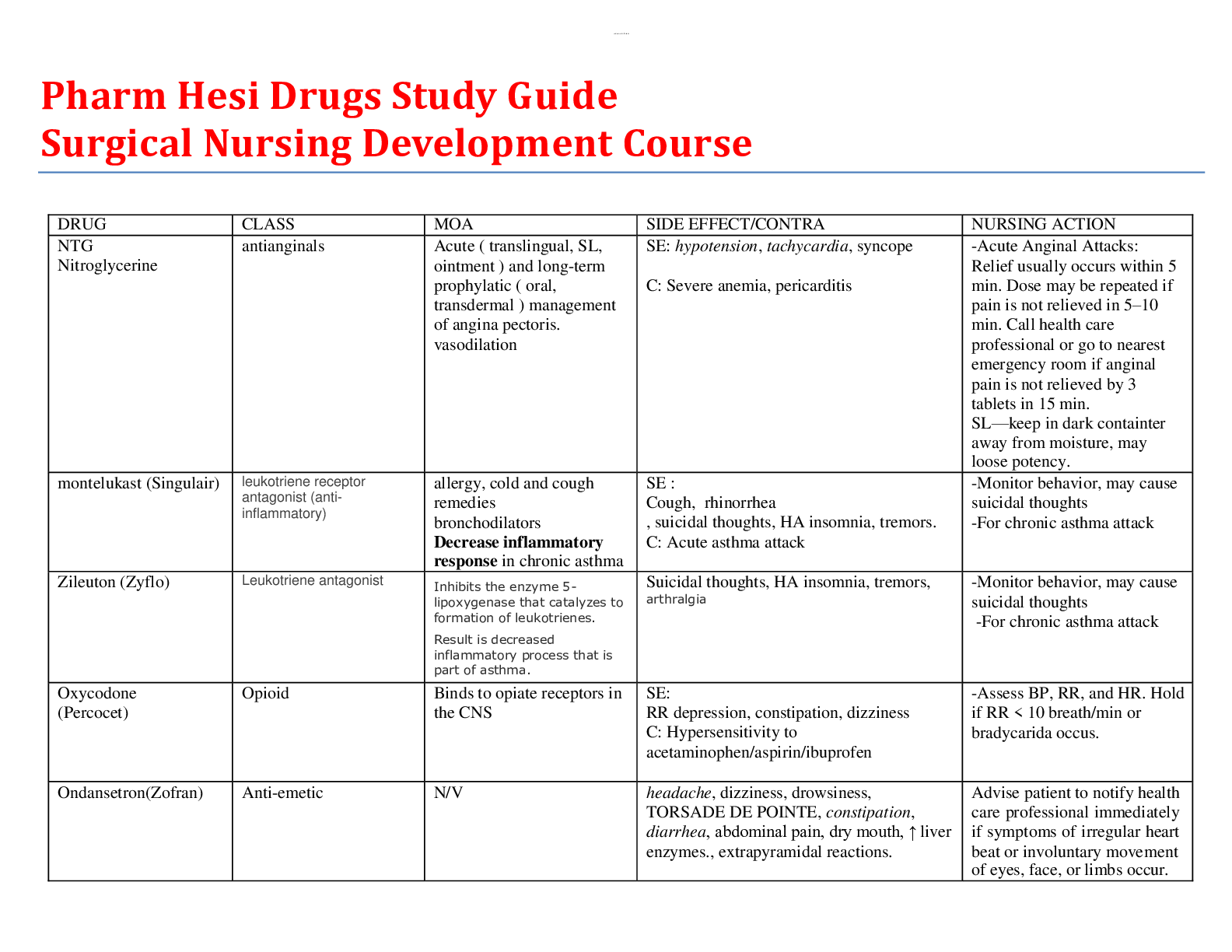

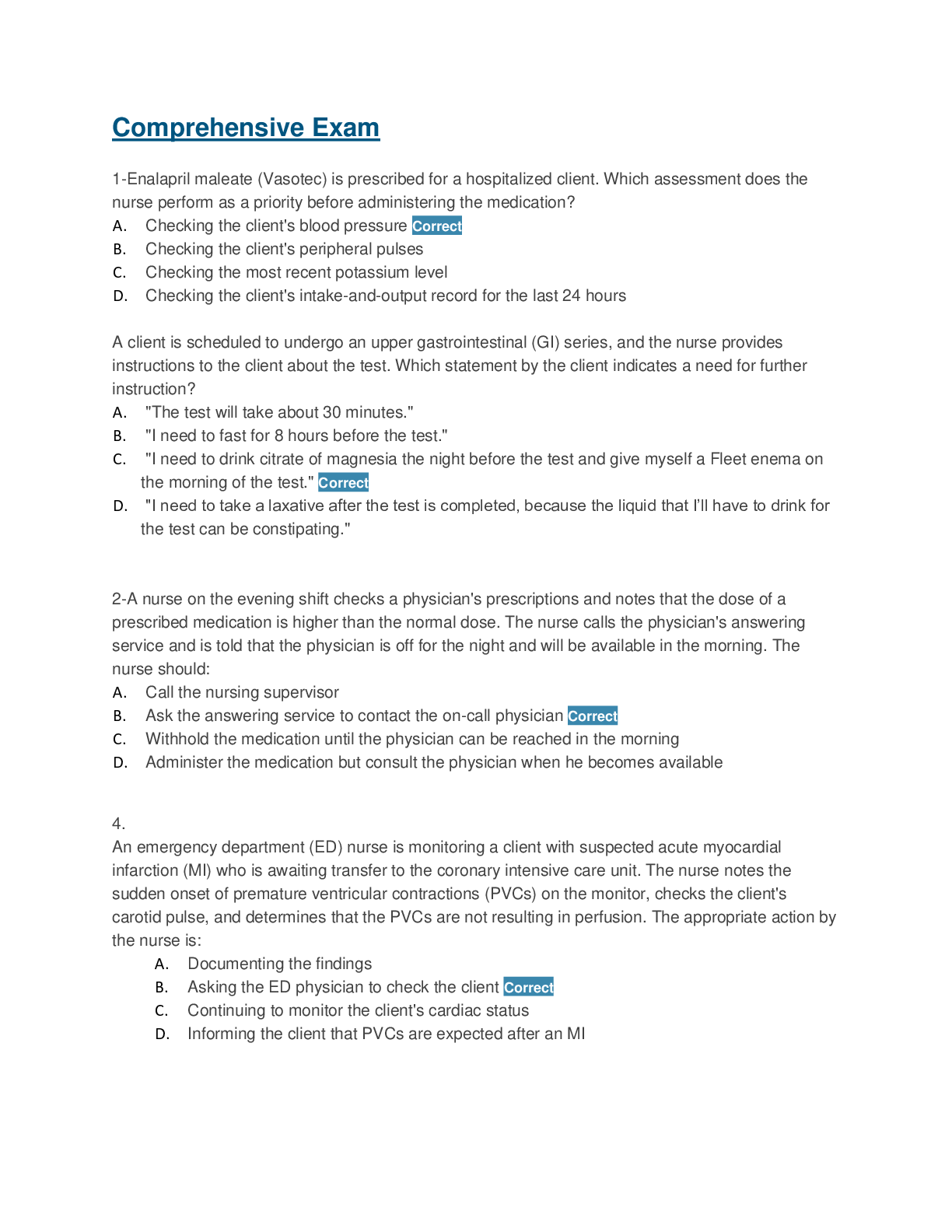


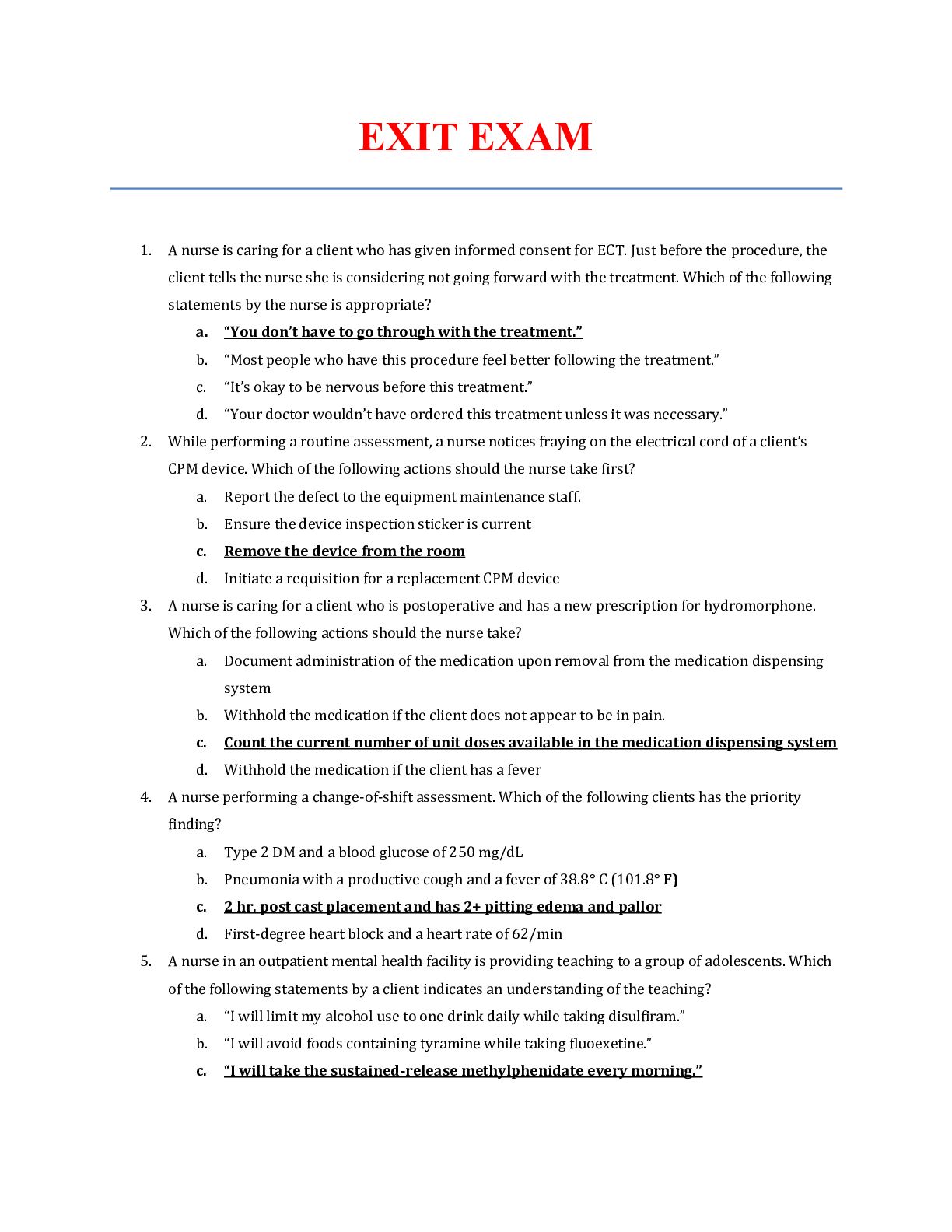
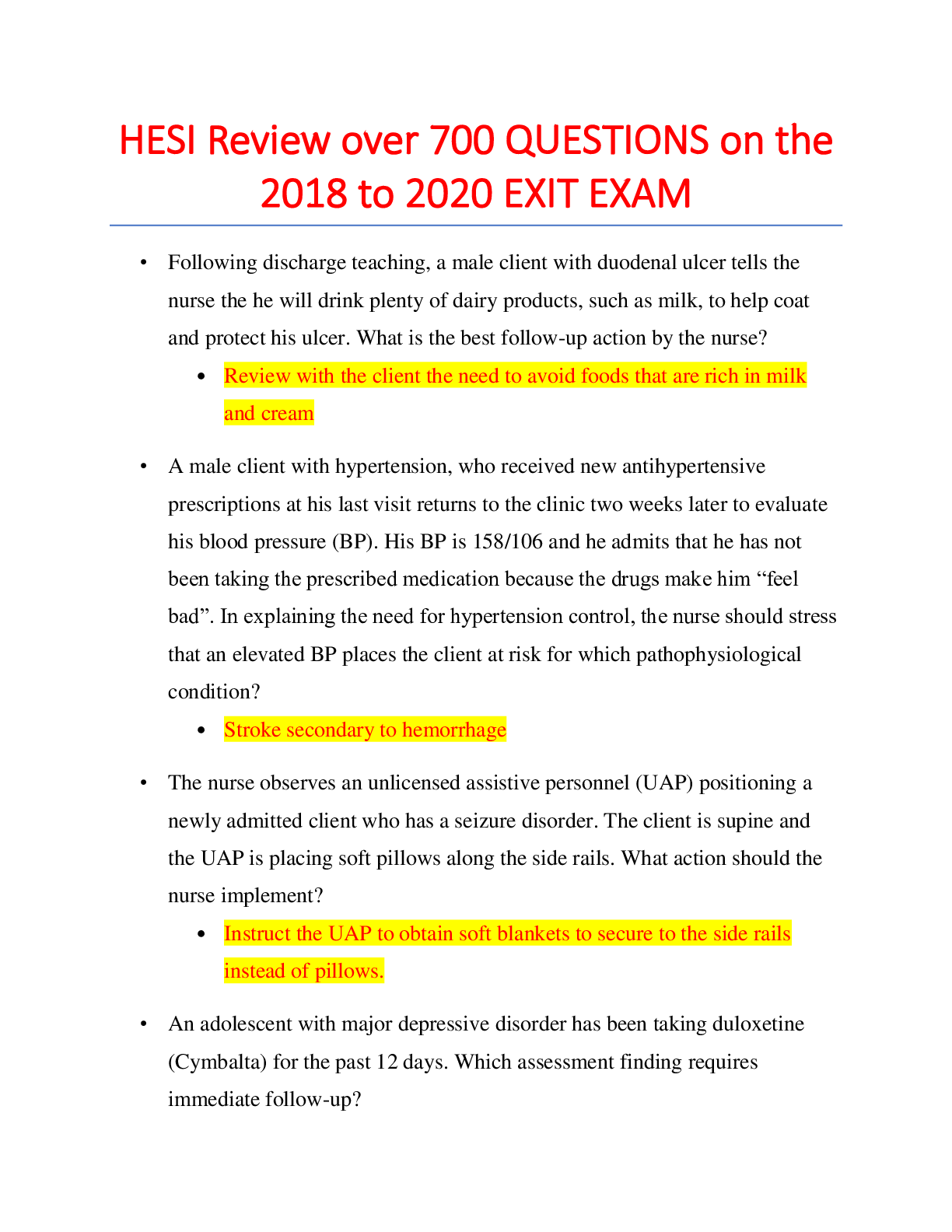




 (1).png)



